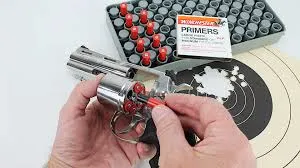Large rifle primers are designed specifically for long-range shooting and offer consistent, reliable ignition for accuracy and bullet velocity. Primers ignite the propellant and require proper handling to prevent accidental ignition. Learning how to handle primers is a necessary safety step when purchasing guns and ammo. Here are a few safety tips for using large rifle primers:
Store Primers Safely
Proper storage of guns and ammo helps prevent accidental discharge. Keep your primers in their original packaging until you’re ready to use them. Safe storage prevents friction, impact, and accidental detonation. Store your primers in a cool, dry place away from electrical sources, heat, and flames. Use separate containers to avoid stocking large quantities of primers together. Handle the primers gently and avoid forcing them into containers that don’t fit. Avoid using any tools or equipment that create excessive force, and keep the primers properly aligned.
Use Safety Equipment
Whether you prime your large rifle manually or with a priming tool, use safety glasses and hearing protection. Using such safety equipment protects your eyes and ears in case of accidental detonation. Use the right priming tools and presses, including appropriate shell holders and components. The priming tools should be clean and in good working condition, and care should be taken to prevent jamming or misalignment. If you encounter unusual resistance, stop immediately and inspect the case and primers. Forced priming can lead to unintended denotation.
Inspect Your Primers
Before priming your large rifles, inspect the primers for unwanted residue or damage. Check for corrosion, dents, and oil, and discard any primers that don’t meet safety standards. Remove containers that carry corroded and dented primers, as they are likely damaged and more prone to accidental detonation. Clean the primer pockets and verify that they provide a secure fit. Avoid loose or tight pockets that can lead to misfires and primer ejection when you fire the rifle.
Use Correct Primers
Large rifle primers require specific cartridges, so verify you are using the right size. Avoid substituting large rifle primers with options designed for small rifles, pistols, and magnums. Check the load data and adhere to its specifications. You can find the load data from your local firearm and ammo supplier or reputable reloading manuals. Using the right primers helps to prevent unreliable performance or damage to your firearm.
Space Primers Correctly
Spacing and aligning large rifle primers accordingly help prevent chain detonations. Chain ignition or detonation occurs when multiple primers detonate at once. Proper alignment and spacing are necessary when using automated or tray-fed priming tools because they can trigger unintended detonations. Avoid striking the primer or forcing stuck primers. Stay focused when priming to avoid distractions that can lead to mistakes and unsafe handling. Work in a well-lit, organized environment without interruption from children or pets.
Remove Defective Primers
If you detect damaged or unusable primers during inspection, dispose of them safely. Dented, oily, or corroded primers should be thrown away. Avoid crushing damaged primers and don’t attempt to fire them. Discard unusable primers in safety bags and keep them out of the reach of children and pets. Avoid reusing or reseating primers that have been pressed in and removed to avoid accidents.
Complete Small Batches
Be aware of your equipment’s limits and prime in small batches to reduce the risk of accidental detonation. Prime as needed for the task, handling a small number of primers at a time. Avoid over-priming, keeping primers flush or slightly below flush. The primers should not stick out because they can prevent bolt closure or cause slam-fire in semi-automatic rifles. Use consistent pressure, and don’t exceed the limit specified for your priming tool or press. Check the rating to verify the specified primer types and volume. Inspect the tools for wear or malfunction and repair any issues before using the tool for priming.
Find Quality Guns and Ammo Today
You can take many other precautions to avoid accidents when priming a large rifle. Avoid contaminants by keeping your hands clean and dry and using level surfaces. Label all reloads to prevent mix-ups and dangerous combinations, and keep a reloading log. To learn how to get started on this process, contact a gun and ammo supplier for high-quality primers and tools.

